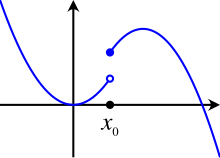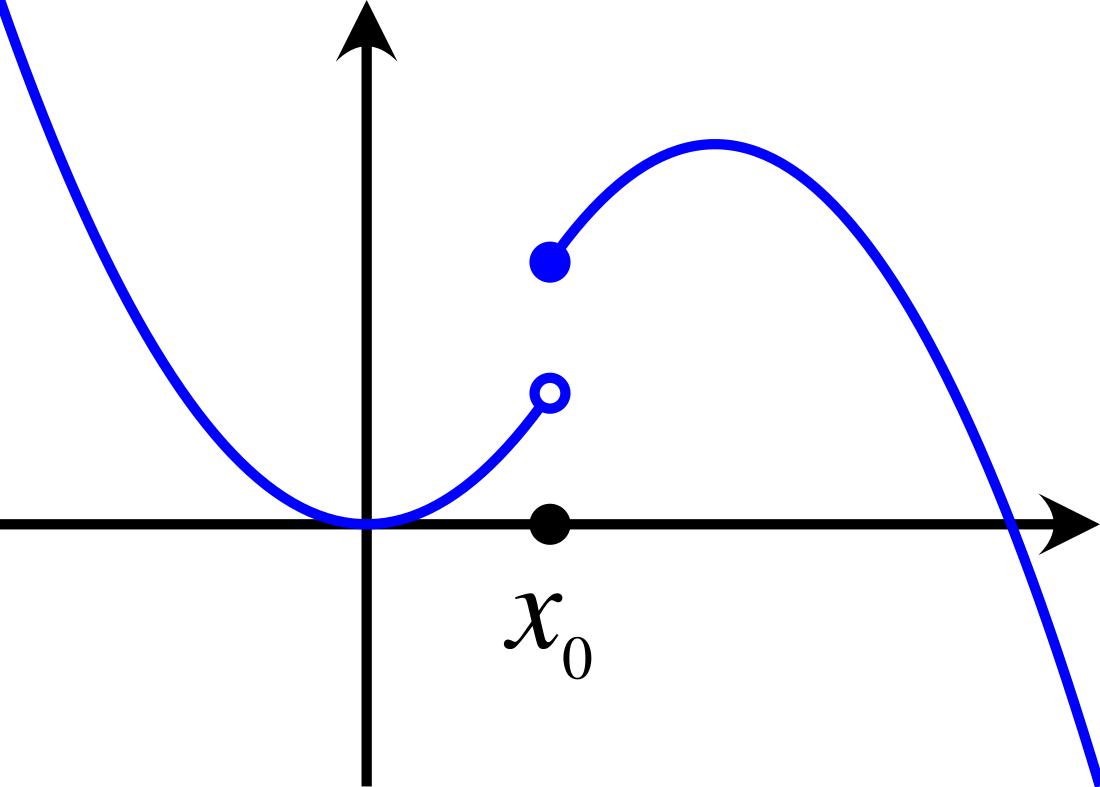In mathematical analysis, semicontinuity (or semi-continuity) is a property of extended real-valued functions that is weaker than continuity. An extended real-valued function is upper (respectively, lower) semicontinuous at a point if, roughly speaking, the function values for arguments near are not much higher (respectively, lower) than
A function is continuous if and only if it is both upper and lower semicontinuous. If we take a continuous function and increase its value at a certain point to for some , then the result is upper semicontinuous; if we decrease its value to then the result is lower semicontinuous.


The notion of upper and lower semicontinuous function was first introduced and studied by René Baire in his thesis in 1899.[1]
Definitions
Assume throughout that is a topological space and is a function with values in the extended real numbers .
Upper semicontinuity
A function is called upper semicontinuous at a point if for every real there exists a neighborhood of such that for all .[2] Equivalently, is upper semicontinuous at if and only if where lim sup is the limit superior of the function at the point
If is a metric space with distance function and this can also be restated using an - formulation, similar to the definition of continuous function. Namely, for each there is a such that whenever
A function is called upper semicontinuous if it satisfies any of the following equivalent conditions:[2]
- (1) The function is upper semicontinuous at every point of its domain.
- (2) For each , the set is open in , where .
- (3) For each , the -superlevel set is closed in .
- (4) The hypograph is closed in .
- (5) The function is continuous when the codomain is given the left order topology. This is just a restatement of condition (2) since the left order topology is generated by all the intervals .
Lower semicontinuity
A function is called lower semicontinuous at a point if for every real there exists a neighborhood of such that for all . Equivalently, is lower semicontinuous at if and only if where is the limit inferior of the function at point
If is a metric space with distance function and this can also be restated as follows: For each there is a such that whenever
A function is called lower semicontinuous if it satisfies any of the following equivalent conditions:
- (1) The function is lower semicontinuous at every point of its domain.
- (2) For each , the set is open in , where .
- (3) For each , the -sublevel set is closed in .
- (4) The epigraph is closed in .[3]: 207
- (5) The function is continuous when the codomain is given the right order topology. This is just a restatement of condition (2) since the right order topology is generated by all the intervals .
Examples
Consider the function piecewise defined by: This function is upper semicontinuous at but not lower semicontinuous.
The floor function which returns the greatest integer less than or equal to a given real number is everywhere upper semicontinuous. Similarly, the ceiling function is lower semicontinuous.
Upper and lower semicontinuity bear no relation to continuity from the left or from the right for functions of a real variable. Semicontinuity is defined in terms of an ordering in the range of the functions, not in the domain.[4] For example the function is upper semicontinuous at while the function limits from the left or right at zero do not even exist.
If is a Euclidean space (or more generally, a metric space) and is the space of curves in (with the supremum distance ), then the length functional which assigns to each curve its length is lower semicontinuous.[5] As an example, consider approximating the unit square diagonal by a staircase from below. The staircase always has length 2, while the diagonal line has only length .
Let be a measure space and let denote the set of positive measurable functions endowed with the topology of convergence in measure with respect to Then by Fatou's lemma the integral, seen as an operator from to is lower semicontinuous.
Tonelli's theorem in functional analysis characterizes the weak lower semicontinuity of nonlinear functionals on Lp spaces in terms of the convexity of another function.
Properties
Unless specified otherwise, all functions below are from a topological space to the extended real numbers Several of the results hold for semicontinuity at a specific point, but for brevity they are only stated for semicontinuity over the whole domain.
- A function is continuous if and only if it is both upper and lower semicontinuous.
- The characteristic function or indicator function of a set (defined by if and if ) is upper semicontinuous if and only if is a closed set. It is lower semicontinuous if and only if is an open set.
- In the field of convex analysis, the characteristic function of a set is defined differently, as if and if . With that definition, the characteristic function of any closed set is lower semicontinuous, and the characteristic function of any open set is upper semicontinuous.
Binary Operations on Semicontinuous Functions
Let .
- If and are lower semicontinuous, then the sum is lower semicontinuous[6] (provided the sum is well-defined, i.e., is not the indeterminate form ). The same holds for upper semicontinuous functions.
- If and are lower semicontinuous and non-negative, then the product function is lower semicontinuous. The corresponding result holds for upper semicontinuous functions.
- The function is lower semicontinuous if and only if is upper semicontinuous.
- If and are upper semicontinuous and is non-decreasing, then the composition is upper semicontinuous. On the other hand, if is not non-decreasing, then may not be upper semicontinuous.[7]
- If and are lower semicontinuous, their (pointwise) maximum and minimum (defined by and ) are also lower semicontinuous. Consequently, the set of all lower semicontinuous functions from to (or to ) forms a lattice. The corresponding statements also hold for upper semicontinuous functions.
Optimization of Semicontinuous Functions
- The (pointwise) supremum of an arbitrary family of lower semicontinuous functions (defined by ) is lower semicontinuous.[8]
- In particular, the limit of a monotone increasing sequence of continuous functions is lower semicontinuous. (The Theorem of Baire below provides a partial converse.) The limit function will only be lower semicontinuous in general, not continuous. An example is given by the functions defined for for
- Likewise, the infimum of an arbitrary family of upper semicontinuous functions is upper semicontinuous. And the limit of a monotone decreasing sequence of continuous functions is upper semicontinuous.
- If is a compact space (for instance a closed bounded interval ) and is upper semicontinuous, then attains a maximum on If is lower semicontinuous on it attains a minimum on
- (Proof for the upper semicontinuous case: By condition (5) in the definition, is continuous when is given the left order topology. So its image is compact in that topology. And the compact sets in that topology are exactly the sets with a maximum. For an alternative proof, see the article on the extreme value theorem.)
Other Properties
- (Theorem of Baire)[note 1] Let be a metric space. Every lower semicontinuous function is the limit of a point-wise increasing sequence of extended real-valued continuous functions on In particular, there exists a sequence of continuous functions such that
- Additionally, every upper semicontinuous function is the limit of a monotone decreasing sequence of extended real-valued continuous functions on if does not take the value the continuous functions can be taken to be real-valued.
- Any upper semicontinuous function on an arbitrary topological space is locally constant on some dense open subset of
- If the topological space is sequential, then is upper semi-continuous if and only if it is sequentially upper semi-continuous, that is, if for any and any sequence that converges towards , there holds . Equivalently, in a sequential space, is upper semicontinuous if and only if its superlevel sets are sequentially closed for all . In general, upper semicontinuous functions are sequentially upper semicontinuous, but the converse may be false.
Semicontinuity of Set-valued Functions
For set-valued functions, several concepts of semicontinuity have been defined, namely upper, lower, outer, and inner semicontinuity, as well as upper and lower hemicontinuity. A set-valued function from a set to a set is written For each the function defines a set The preimage of a set under is defined as That is, is the set that contains every point in such that is not disjoint from .[11]
Upper and Lower Semicontinuity
A set-valued map is upper semicontinuous at if for every open set such that , there exists a neighborhood of such that [11]: Def. 2.1
A set-valued map is lower semicontinuous at if for every open set such that there exists a neighborhood of such that [11]: Def. 2.2
Upper and lower set-valued semicontinuity are also defined more generally for a set-valued maps between topological spaces by replacing and in the above definitions with arbitrary topological spaces.[11]
Note, that there is not a direct correspondence between single-valued lower and upper semicontinuity and set-valued lower and upper semicontinuouty. An upper semicontinuous single-valued function is not necessarily upper semicontinuous when considered as a set-valued map.[11]: 18 For example, the function defined by is upper semicontinuous in the single-valued sense but the set-valued map is not upper semicontinuous in the set-valued sense.
Inner and Outer Semicontinuity
A set-valued function is called inner semicontinuous at if for every and every convergent sequence in such that , there exists a sequence in such that and for all sufficiently large [12][note 2]
A set-valued function is called outer semicontinuous at if for every convergence sequence in such that and every convergent sequence in such that for each the sequence converges to a point in (that is, ).[12]
See also
- Directional continuity – Mathematical function with no sudden changes
- Katětov–Tong insertion theorem – On existence of a continuous function between semicontinuous upper and lower bounds
- Hemicontinuity – Semicontinuity for set-valued functions
- Càdlàg – Right continuous function with left limits
Notes
- The result was proved by René Baire in 1904 for real-valued function defined on . It was extended to metric spaces by Hans Hahn in 1917, and Hing Tong showed in 1952 that the most general class of spaces where the theorem holds is the class of perfectly normal spaces. (See Engelking, Exercise 1.7.15(c), p. 62 for details and specific references.)
- In particular, there exists such that for every natural number . The necessisty of only considering the tail of comes from the fact that for small values of the set may be empty.
References
Bibliography
Wikiwand in your browser!
Seamless Wikipedia browsing. On steroids.
Every time you click a link to Wikipedia, Wiktionary or Wikiquote in your browser's search results, it will show the modern Wikiwand interface.
Wikiwand extension is a five stars, simple, with minimum permission required to keep your browsing private, safe and transparent.








![{\displaystyle {\overline {\mathbb {R} }}=\mathbb {R} \cup \{-\infty ,\infty \}=[-\infty ,\infty ]}](http://wikimedia.org/api/rest_v1/media/math/render/svg/b095388ff2cb62df5a45671a0d2dae6dd9ff4db9)





























![{\displaystyle f^{-1}((y,\infty ])=\{x\in X:f(x)>y\}}](http://wikimedia.org/api/rest_v1/media/math/render/svg/272409a931166756ce2b7a7f5d61addf37debcf2)
![{\displaystyle (y,\infty ]=\{t\in {\overline {\mathbb {R} }}:t>y\}}](http://wikimedia.org/api/rest_v1/media/math/render/svg/d11d06cc7126d67bbd5f8d5ca4d0386d386b5d1a)
![{\displaystyle f^{-1}((-\infty ,y])=\{x\in X:f(x)\leq y\}}](http://wikimedia.org/api/rest_v1/media/math/render/svg/ccf04b7f5717be347b1db24d9fe217381b32aeb3)

![{\displaystyle (y,\infty ]}](http://wikimedia.org/api/rest_v1/media/math/render/svg/1a68e44010ee6b3e4ce49e177dc9bb343833a799)









![{\displaystyle \Gamma =C([0,1],X)}](http://wikimedia.org/api/rest_v1/media/math/render/svg/ec5e166b2c51fd7a377e58ccb71fd1f445fc7732)
![{\displaystyle d_{\Gamma }(\alpha ,\beta )=\sup\{d_{X}(\alpha (t),\beta (t)):t\in [0,1]\}}](http://wikimedia.org/api/rest_v1/media/math/render/svg/70a1f48434a8ad4fece85cd420bf0ddbdc767a4d)
![{\displaystyle L:\Gamma \to [0,+\infty ],}](http://wikimedia.org/api/rest_v1/media/math/render/svg/9ae1609c7c11f3aa1f8de31b212f52fb0ed747a5)






![{\displaystyle [-\infty ,+\infty ]}](http://wikimedia.org/api/rest_v1/media/math/render/svg/a7a5a5ba47896e8fdd43cf7f311db27350f0f8ff)
![{\displaystyle {\overline {\mathbb {R} }}=[-\infty ,\infty ].}](http://wikimedia.org/api/rest_v1/media/math/render/svg/c99d0218a0b787a96d52c204201e1c27f520914a)
























![{\displaystyle x\in [0,1]}](http://wikimedia.org/api/rest_v1/media/math/render/svg/64a15936df283add394ab909aa7a5e24e7fb6bb2)


![{\displaystyle [a,b]}](http://wikimedia.org/api/rest_v1/media/math/render/svg/9c4b788fc5c637e26ee98b45f89a5c08c85f7935)























































